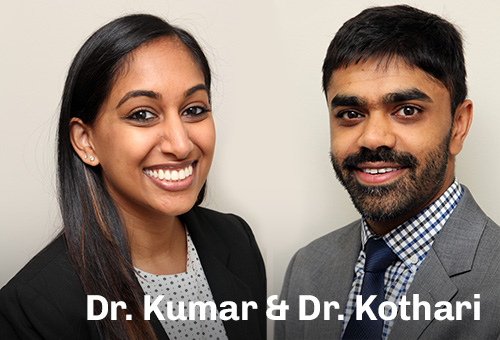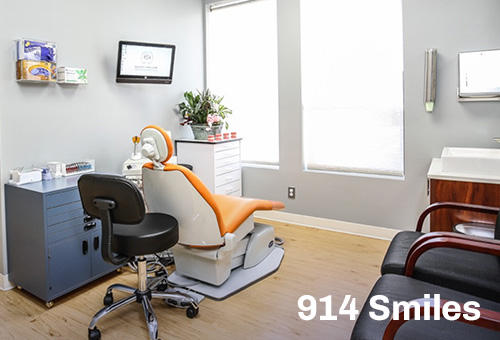
As a parent, you know that brushing, flossing and taking your child to the dentist are essential for preventing cavities and gum disease and helping them maintain A+ oral health. But did you also know that the alignment of your child’s teeth and jaws play a role in their oral health and function too? That’s why it’s recommended little ones have an orthodontic evaluation by age 7.
Seeing an orthodontist at a young age doesn’t automatically mean appliances or braces for kids. In most cases, it will just start an observational period. Your child will simply come in for occasional visits so our Tarrytown orthodontist, Dr. Rishi Kothari, can monitor their developing smile and let you know when the time is right for them to get braces or clear aligners.
Sometimes, however, if certain emerging problems are identified, interceptive orthodontics could be recommended. Also known as phase 1 orthodontic treatment or early orthodontics, interceptive orthodontics corrects bite and alignment issues before they become full-blown problems. The goal is to prevent the need for more extensive treatment for your child down the line.
In this post, we’ll be covering the ins and outs of interceptive orthodontics to give you a better understanding of when it’s needed, how it works and what the benefits are.

What Is Early Interceptive Orthodontic Treatment?
Early interceptive orthodontic treatment harnesses a child’s rapid growth to guide jaw growth and make room for the permanent teeth to erupt. It can be used to correct issues like underbites, crossbites and excessive crowding. The purpose of early intervention is not only to save money but to also reduce the extent of your child’s treatment in later years.
Facts you should know about interceptive orthodontic treatment:
- Interceptive orthodontics treats children between 7-11 years of age to take advantage of their malleable bones.
- Phase 1 orthodontic treatment begins while there is still a mix of primary (baby) teeth and permanent teeth.
- Early intervention reduces the need for tooth extractions and corrective jaw surgery in the future.
- Interceptive orthodontics is not a substitute replacement for comprehensive orthodontic treatment, however, it does prepare a child’s mouth for ideal, healthy tooth growth.
- Comprehensive orthodontic treatment, or phase 2 treatment, with braces or clear aligners generally starts between the ages of 12 and 14 once all of the permanent teeth have erupted.
- Interceptive orthodontics makes braces or clear aligner treatment in the teen years much easier!
When does interceptive orthodontic treatment start?
The American Association of Orthodontics (AAO) recommends that children have their first check-up with an orthodontist no later than the age of 7. Around this age, your child usually has enough permanent teeth for the orthodontist to evaluate their developing teeth and jaws.
As noted above, interceptive orthodontic treatment usually starts between the ages of 7 and 11 while your child still has some baby teeth present. For certain types of malocclusion (bad bite), this is the ideal age to intervene because we’re able to help the permanent teeth come in properly.
If your child is suffering from an orthodontic issue earlier than age 7, it is recommended that you bring them in for a check-up at 914 Smiles!
Does my child need interceptive orthodontics?
The only way to know if your child needs interceptive orthodontics is to have them evaluated by a certified specialist in orthodontics. A child’s teeth can look pretty straight, but they could have a subtle issue with their bite that will cause significant problems. Or, a child could appear to have a huge orthodontic problem that’s actually something that will correct itself as your child grows.
Orthodontists like Dr. Kothari have in-depth specialty training in dental and facial development. This means Dr. Kothari can identify red flags in their earliest stages, accurately diagnose orthodontic concerns and offer expert guidance on the perfect age for your child to start treatment.
While we always treat kids conservatively at 914 Smiles, some of the dental issues that may need interceptive treatment include:
- Protruding teeth;
- Excessive crowding;
- Crossbites;
- Severe overbites (i.e., bottom teeth bite into the soft tissues behind the top teeth);
- Underbites;
- Upper and lower jaw growing at different rates;
- Early loss of baby teeth;
- Narrow dental arches
Benefits Of Early Interceptive Orthodontic Treatment
Helping your child get their best smile at a young age does wonders for their self-confidence. But there are many more advantages beyond a self-esteem boost. When needed, other benefits of early orthodontics for your child include:
Correcting habits like thumb sucking
Prolonged, aggressive thumb sucking, pacifier use or tongue thrust can cause the upper jaw and palate to narrow and the front teeth to protrude. Interceptive orthodontics works to curb the habits and any changes they’re causing in the jaw.
Correcting problems, such as crossbites, overbites and underbites
These bite problems not only cause jaw pain and dysfunction but can also increase the risk of tooth decay and gum disease, cause excessive enamel wear, interfere with biting, chewing and speaking and impact the airway. In cases of a crossbite, kids often compensate by shifting their jaw to one side, which may cause permanent changes in their facial structure.
Early orthodontics modifies the growth of your child’s jaw and creates healthy space for your child’s adult teeth, warding off the problems caused by misalignment.
Making future treatment easier and more affordable
Early interceptive orthodontics can lessen the duration of treatment later in your child’s life and prevent more severe oral problems from taking form. It also reduces the need for corrective jaw surgery and extractions.
Clearer prognosis of how permanent teeth will take shape
Early interceptive orthodontic treatment helps your orthodontist predict how your child’s adult teeth will emerge. With more space, the permanent teeth can then be shifted into their ideal places during phase 2 treatment.
Reducing the risk of tooth decay and gum disease
Crowded teeth can result in improper cleaning and poor oral hygiene. Getting into those nooks and crannies can be hard when your child’s teeth overlap. Tooth decay and gum disease at a young age can have adverse side effects later in life. By promoting optimal spacing, early orthodontics can make the teeth easier to clean.
Fixing facial asymmetry by guiding jawbone growth
Guiding the growth of your child’s jaw can help to create a more symmetrical face and healthy, stable bite.
Lowering the risk of damage to protruding teeth
Appliances or braces for kids can move protruding teeth back and out of harm’s way.
Alleviating speech problems
A lack of room for the tongue to move freely, misaligned teeth or skeletal imbalances can cause speech difficulties. When not treated, speech habits may become ingrained and harder to fix. In some cases, early orthodontics can be beneficial.
How Does Interceptive Orthodontics Work?
Most kids who have phase 1 orthodontic treatment will also need phase 2 orthodontic treatment. This is because phase 1 treatment has very limited goals and is aimed at skeletal correction and/or making space for the permanent teeth. Once the permanent teeth erupt, phase 2 treatment with braces or aligners shifts them into place and helps us finetune the bite for lasting results.
Here’s how two-phase treatment works:
Phase 1
During the first stage, we use certain orthodontic appliances, such as a palatal expander, to guide jaw growth. The type of phase 1 appliance will depend on your child’s needs. We aim to finish this phase of treatment in 12 months or less.
Resting Period
When we achieve our goals, we’ll remove your child’s phase 1 appliance. They’ll begin a resting period where we allow the remainder of their primary teeth to fall out and their permanent teeth to erupt. They may or may not wear a retainer during this time.
Phase 2
When your child has all of their permanent teeth (aside from their wisdom teeth), they’ll start phase 2 orthodontic treatment, usually around age 12 or 13. Dr. Kothari will place braces on their teeth or design custom clear aligners for them to wear.
Retention
When your child, or now your teenager, finishes braces or clear aligner treatment, they’ll have a beautiful, healthy smile and strong, functional bite. To prevent their teeth from shifting and ensure their results last a lifetime, we’ll create custom retainers for them to wear to hold their teeth in position.
Orthodontics For kids In Tarrytown, NY
With pediatric dentistry and orthodontics under one roof, we make caring for your child’s smile convenient. If your child is a patient of our pediatric dentist, Dr. Reshma Kumar, she can easily refer them to our orthodontist, Dr. Kothari, as soon as she spots a concern.
However, whether your child is a patient or not, it’s still in their best interest to schedule an orthodontic evaluation with Dr. Kothari by age 7. He will assess your child’s teeth and jaws and screen for emerging issues. Most kids won’t need interceptive orthodontics but for those who do, early intervention can be life-changing. Book a complimentary exam for your child with our Tarrytown orthodontist today!



